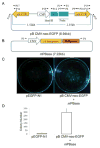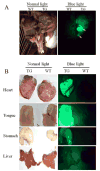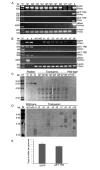Pig transgenesis by piggyBac transposition in combination with somatic cell nuclear transfer
- PMID: 23857557
- PMCID: PMC3838457
- DOI: 10.1007/s11248-013-9729-0
Pig transgenesis by piggyBac transposition in combination with somatic cell nuclear transfer
Abstract
The production of animals by somatic cell nuclear transfer (SCNT) is inefficient, with approximately 2% of micromanipulated oocytes going to term and resulting in live births. However, it is the most commonly used method for the generation of cloned transgenic livestock as it facilitates the attainment of transgenic animals once the nuclear donor cells are stably transfected and more importantly as alternatives methods of transgenesis in farm animals have proven even less efficient. Here we describe piggyBac-mediated transposition of a transgene into porcine primary cells and use of these genetically modified cells as nuclear donors for the generation of transgenic pigs by SCNT. Gene transfer by piggyBac transposition serves to provide an alternative approach for the transfection of nuclear donor cells used in SCNT.
Figures




Similar articles
-
Characterization of Growth and Reproduction Performance, Transgene Integration, Expression, and Transmission Patterns in Transgenic Pigs Produced by piggyBac Transposition-Mediated Gene Transfer.Anim Biotechnol. 2016 Oct;27(4):245-55. doi: 10.1080/10495398.2016.1178140. Anim Biotechnol. 2016. PMID: 27565868 Free PMC article.
-
The piggyBac-Based Gene Delivery System Can Confer Successful Production of Cloned Porcine Blastocysts with Multigene Constructs.Int J Mol Sci. 2016 Aug 30;17(9):1424. doi: 10.3390/ijms17091424. Int J Mol Sci. 2016. PMID: 27589724 Free PMC article.
-
Production of transgenic cloned piglets from genetically transformed fetal fibroblasts selected by green fluorescent protein.Theriogenology. 2005 Mar 1;63(4):973-91. doi: 10.1016/j.theriogenology.2004.04.017. Theriogenology. 2005. PMID: 15710186
-
Creating genetically modified pigs by using nuclear transfer.Reprod Biol Endocrinol. 2003 Nov 7;1:82. doi: 10.1186/1477-7827-1-82. Reprod Biol Endocrinol. 2003. PMID: 14613542 Free PMC article. Review.
-
Development of efficient strategies for the production of genetically modified pigs.Theriogenology. 2003 Jan 1;59(1):95-106. doi: 10.1016/s0093-691x(02)01261-x. Theriogenology. 2003. PMID: 12499021 Review.
Cited by
-
Characterization of Growth and Reproduction Performance, Transgene Integration, Expression, and Transmission Patterns in Transgenic Pigs Produced by piggyBac Transposition-Mediated Gene Transfer.Anim Biotechnol. 2016 Oct;27(4):245-55. doi: 10.1080/10495398.2016.1178140. Anim Biotechnol. 2016. PMID: 27565868 Free PMC article.
-
In Vivo Piggybac-Based Gene Delivery towards Murine Pancreatic Parenchyma Confers Sustained Expression of Gene of Interest.Int J Mol Sci. 2019 Jun 26;20(13):3116. doi: 10.3390/ijms20133116. Int J Mol Sci. 2019. PMID: 31247905 Free PMC article.
-
Applications of piggyBac Transposons for Genome Manipulation in Stem Cells.Stem Cells Int. 2021 Sep 14;2021:3829286. doi: 10.1155/2021/3829286. eCollection 2021. Stem Cells Int. 2021. PMID: 34567130 Free PMC article. Review.
-
Optimization of piggyBac Transposon System Electrotransfection in Sheep Fibroblasts.Mol Biotechnol. 2023 Oct;65(10):1585-1597. doi: 10.1007/s12033-023-00659-5. Epub 2023 Jan 27. Mol Biotechnol. 2023. PMID: 36705779
-
Potential for Isolation of Immortalized Hepatocyte Cell Lines by Liver-Directed In Vivo Gene Delivery of Transposons in Mice.Stem Cells Int. 2019 Jun 2;2019:5129526. doi: 10.1155/2019/5129526. eCollection 2019. Stem Cells Int. 2019. PMID: 31281376 Free PMC article. Review.
References
-
- Al-Mashhadi RH, Sorensen CB, Kragh PM, Christoffersen C, Mortensen MB, Tolbod LP, Thim T, Du Y, Li J, Liu Y, Moldt B, Schmidt M, Vajta G, Larsen T, Purup S, Bolund L, Nielsen LB, Callesen H, Falk E, Mikkelsen JG, Bentzon JF. Familial hypercholesterolemia and atherosclerosis in cloned minipigs created by DNA transposition of a human PCSK9 gain-of-function mutant. Science translational medicine. 2013;5(166):166ra–161. doi: 10.1126/scitranslmed.3004853. - DOI - PubMed
-
- Betthauser J, Forsberg E, Augenstein M, Childs L, Eilertsen K, Enos J, Forsythe T, Golueke P, Jurgella G, Koppang R, Lesmeister T, Mallon K, Mell G, Misica P, Pace M, Pfister-Genskow M, Strelchenko N, Voelker G, Watt S, Thompson S, Bishop M. Production of cloned pigs from in vitro systems. Nature biotechnology. 2000;18(10):1055–1059. doi: 10.1038/80242. - DOI - PubMed
Publication types
MeSH terms
Substances
Grants and funding
LinkOut - more resources
Full Text Sources
Other Literature Sources

